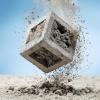
Breaking News
 Japan just injected artificial blood into a human. No blood type needed. No refrigeration.
Japan just injected artificial blood into a human. No blood type needed. No refrigeration.
 China Just Dropped a 6% TAX on Gold - The Market Wasn't Ready for This
China Just Dropped a 6% TAX on Gold - The Market Wasn't Ready for This
 Banks' Strategic Silver Market Manipulation During Off-Hours Trading
Banks' Strategic Silver Market Manipulation During Off-Hours Trading
 No new North Sea oil wells for first time since 1960
No new North Sea oil wells for first time since 1960
Top Tech News
 The 6 Best LLM Tools To Run Models Locally
The 6 Best LLM Tools To Run Models Locally
 Testing My First Sodium-Ion Solar Battery
Testing My First Sodium-Ion Solar Battery
 A man once paralyzed from the waist down now stands on his own, not with machines or wires,...
A man once paralyzed from the waist down now stands on his own, not with machines or wires,...
 Review: Thumb-sized thermal camera turns your phone into a smart tool
Review: Thumb-sized thermal camera turns your phone into a smart tool
 Army To Bring Nuclear Microreactors To Its Bases By 2028
Army To Bring Nuclear Microreactors To Its Bases By 2028
 Nissan Says It's On Track For Solid-State Batteries That Double EV Range By 2028
Nissan Says It's On Track For Solid-State Batteries That Double EV Range By 2028
 Carbon based computers that run on iron
Carbon based computers that run on iron
 Russia flies strategic cruise missile propelled by a nuclear engine
Russia flies strategic cruise missile propelled by a nuclear engine
 100% Free AC & Heat from SOLAR! Airspool Mini Split AC from Santan Solar | Unboxing & Install
100% Free AC & Heat from SOLAR! Airspool Mini Split AC from Santan Solar | Unboxing & Install
 Engineers Discovered the Spectacular Secret to Making 17x Stronger Cement
Engineers Discovered the Spectacular Secret to Making 17x Stronger Cement
A NEW SPACECRAFT IS JOURNEYING TO THE SUN TO GET A NEVER-BEFORE-SEEN...

This weekend, the European Space Agency and NASA are launching a new, hardened spacecraft bound for the center of our Solar System, where it will get a view of our Sun that no vehicle has seen before. The probe, dubbed the Solar Orbiter, will be tasked with observing the Sun's poles, in hopes of better predicting how our parent star behaves.
Up until now, practically all vehicles we have sent toward the Sun have stuck around the star's mid-section, orbiting in line with all the planets in the Solar System. But the Solar Orbiter is set to fly a path around the Sun at a high angle, so that it can get a glimpse of the polar regions that have eluded our observations for so long. Just like Earth, the Sun also has poles on its "top" and "bottom," but they've been hard to see since our planet orbits near the Sun's equator.
Once in this lopsided orbit, the Solar Orbiter will come within 26 million miles, or 42 million kilometers, of the Sun, gathering images and data from a truly unique vantage point. Hopefully, this new information can help scientists figure out some of the mysteries of our star that have remained unsolved for decades. Specifically, they want to know what drives our star's strange 11-year cycle, where it alternates between times of intense activity and times of quiet.
"We understand the cyclic behavior; we've observed it for 400 years, ever since people have pointed the telescope at the Sun," Daniel Müller, the ESA's project scientist for the Solar Orbiter mission, tells The Verge. "But we don't really know why it is 11 years and obviously [what drives] the strength of the cycle."



